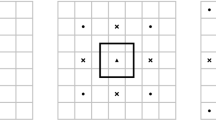Abstract
“Defiltering-Transport-Filtering” (DTF) algorithms are proposed for the large eddy simulation of incompressible flows by using high order methods. These new algorithms are based (i) on an approximate deconvolution method for the modeling of the sub-grid scale stress tensor and (ii) on a semi-Lagrangian method to handle the convective term. Such algorithms are implemented in 3D spectral solvers (one homogeneous direction), using differential operators to handle in an approximate way the filtering and defiltering operations. Stability and dissipation properties of the schema are discussed. Preliminary results, obtained with a Chebyshev collocation solver, for the 3D wake of a cylinder with Reynolds number equal to 1000 are presented.
Similar content being viewed by others
REFERENCES
Bardina, J., et al. (1983). Improved Turbulence Models Based on Large Eddy Simulation of Homogeneous Incompressible Turbulence, Stanford University, Report TF-19.
Domaradzki, J. A., and Saiki, E. M. (1997). A subgrid-scale model based on the estimation of unresolved scales of turbulence. Phys. Fluids 9(7), 2148–2164.
Geurt, B. J. (1997). Inverse modeling for large-eddy simulation. Phys. Fluids 9(12), 3585–3587.
Fischer, P., and Mullen, J. (2001). Filter-based stabilization of spectral element methods. C. R. Acad. Sci. Paris 332(1), 265–270.
Forestier, M. Y., et al. (2000). Computations of 3D wakes in stratified fluids. Computational Fluid Dynamics Conference ECCOMAS 2000, proc. in CD.
Garnier, E., et al. (1999). On the use of shock-capturing schemes for large-eddy simulation. J. Comp. Phys. 153, 273–311.
Germano, M., et al. (1991). A dynamic sub-grid scale eddy viscosity model. Phys. Fluids 3(7), 1760–1765.
Ghosal, S., and Moin, P. (1995). The basic equations for the large-eddy simulation of turbulent flows in complex geometry. J. Comp. Phys. 118, 24–37.
Ghosal, S. (1996). An analysis of numerical errors in large-eddy simulation of turbulence. J. Comp. Phys. 125, 187–206.
Henderson, R. D. (1997). Nonlinear dynamics and pattern formation in turbulent wake transition. J. Fluid Mech. 352, 65–112.
Karamanos, G. S., and Karniadakis, G. E. (2000). A spectral vanishing viscosity method for large-eddy simulation. J. Comp. Phys. 163, 22–50.
Katopodes, F. V., et al. (2000). A Theory for the Subfilter-Scale Model in Large-Eddy Simulation, Stanford University. Technical Report 2000-K1.
Kravchenko, A. G., and Moin, P. (1997). On the effect of numerical errors in large-eddy simulations of turbulent flows. J. Comp. Phys. 131, 312–322.
Lesieur, M. (1990). Turbulence in Fluids, Kluwer Academic, Dordrecht.
Lesieur, M., and Métais, O. (1996). New trends in large-eddy simulation of turbulence. Annu. Rev. Fluid Mech. 28, 45–82.
Maday, Y., et al. (1993). Legendre pseudo-spectral viscosity method for nonlinear conservation laws. SIAM J. Numer. Anal. 30(2), 321–342.
Maday, Y., et al. (1990). An operator-integration-factor splitting method for time-dependent problems: Application to incompressible fluid flow. J. Sci. Comp. 5(4), 263–292.
Phillips, R. M., and Phillips, T. N. (2000). Flow past a cylinder using a semi-Lagrangian spectral element method. Appl. Num. Math 33, 251–257.
Sabbah, C., and Pasquetti, R. (1998). A divergence-free multi-domain spectral solver of the Navier–Stokes equations in geometries of high aspect ratio. J. Comput. Phys. 139, 359–379.
Sagaut, P. (1998), Introduction à la Simulation des Grandes É chelles pour les Écoulements de Fluide Incompressible, Mathématiques & Applications, Springer.
Stolz, S., and Adams, N. A. (1999). An approximate deconvolution procedure for large-eddy simulation. Phys. Fluids 11(7), 1699–1701.
Stolz, S., et al. (2001). An approximate deconvolution model for large-eddy simulation with application to incompressible wall-bounded flows. Phys. Fluids 13(4), 997–1015.
Tadmor, E. (1989). Convergence of spectral methods for nonlinear conservation laws. SIAM J. Numer. Anal. 26(1), 30–44.
Williamson, C. H. K. (1989). Oblique and parallel modes of vortex shedding in the wake of a circular cylinder at low Reynolds numbers. J. Fluid Mech. 206, 579–627.
Xu, C. J., and Pasquetti, R. (2001). On the efficiency of semi-implicit and semi-Lagrangian spectral methods for the calculation of incompressible flows. Int. J. Numer. Meth. Fluids 35, 319–340.
Author information
Authors and Affiliations
Rights and permissions
About this article
Cite this article
Pasquetti, R., Xu, C.J. High-Order Algorithms for Large-Eddy Simulation of Incompressible Flows. Journal of Scientific Computing 17, 273–284 (2002). https://doi.org/10.1023/A:1015169102227
Issue Date:
DOI: https://doi.org/10.1023/A:1015169102227




